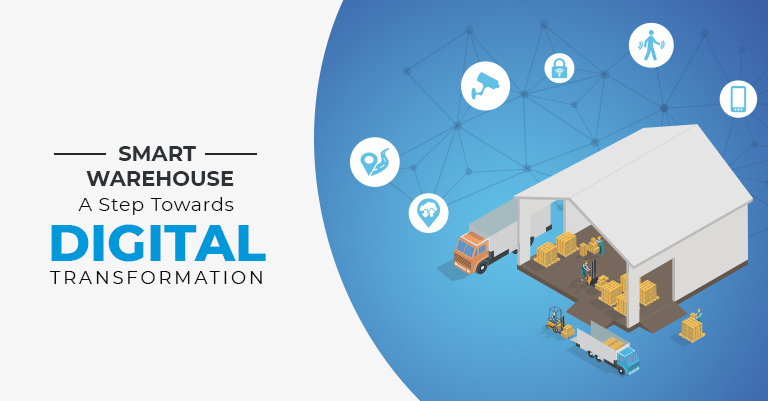
Smart Warehouse – A Step Towards Digital Transformation
Posted On: November 20, 2018
Gone are the days when goods were stored in old dingy godowns on the outskirts of villages and towns. Back then, those poorly lit warehouses were neither managed properly nor were they perfectly secured. But the increasing international trade and domestic consumption have completely revolutionized the way Indian warehouses work. From poorly lit godowns to IoT enabled smart warehouses, logistics has emerged as the backbone of the manufacturing and e-commerce industry.
Indian warehousing sector has from the beginning faced number of challenges related to security, safety, and business efficiency, and to conquer these challenges, businesses leverage IoT to have real-time visibility on all the operational and supply chain processes.
According to a report by Cisco and DHL, IoT will provide $1.9 trillion boosts to supply chain and logistics operations.
Below are the top 5 challenges addressed by IoT based smart warehouses through digital transformation-
-
Security –
Warehouses store loads of goods which makes them prone to internal, external thefts, burglary, and pilferage. IoT sensors help businesses keep a 24/7 visibility on all the operational procedures in warehouses. Stakeholders get real-time alerts and notifications as soon as any unexpected activity happens or when there is a human motion detected in a prohibited area.
-
Distributed monitoring –
Previously, it was difficult for enterprises to monitor and manage multiple sites at the same time. But, as real-time data access is becoming important to meet costumers’ expectations, so enterprises are increasingly leveraging IoT which offers them a single dashboard for centralized monitoring of distributed sites.
Decathlon, the largest sporting goods retailer in the world, uses IoT technology to track millions of its products across the globe. IoT sensors have helped the leading sports retailer to ensure its products are delivered to vendors with 100% accuracy.
-
Reactive surveillance systems –
The old surveillance systems were reactive i.e they did not provide any real-time alerts on detecting any unexpected activity, whereas the IoT technology integrated with modern cloud video surveillance systems is pro-active. It immediately notifies you as soon as it spots any scenario of intrusion, robbery or pilferage. As a result, businesses can take pro-active safety steps to secure their enterprises.
-
Productivity benchmarks –
Warehouse IoT solution aids in improving operational processes and cost optimization. IoT helps in identifying gaps in employee productivity as well as other business processes and aids stakeholders to terminate unwanted procedures in order to enhance business efficiency.
IoT platform helps businesses to discover delays and slowdowns that affects their bottom line and costs them money so that they can execute necessary steps to correct them and increase business efficiency.DHL is the world’s largest logistics company, providing international courier, parcel, and express mail services. It uses warehouse IoT solution for freight transportation. IoT sensors help DHL to monitor freight location, container openings, vibrations, stroke or any damage to the cargo. Also, it helps inbound trucks to prioritize the needs of the manufacturing site and helps shipments to be unloaded at the appropriate dock. It reduces waiting time for drivers from an average waiting time of 40 minutes, consequently minimizing the risks of manufacturing delays as goods arrive on time and resources are optimized appropriately.
-
Analytics –
A study by the council of supply chain management shows that 98% of third-party logistics firms believe that data-driven decision making is crucial for supply chain activities.
IoT platform provides actionable reports that enable businesses to take real-time actions for enhancing business efficiency and cost optimization. Analytics provide insights for numerous operational processes and facilitate key decision making for faster loading and dispatch time. It helps to enhance safety and maintain an ideal storage temperature. Analytics for logistics aids in measuring accuracy, product tracking trace-ability and transportation performance.
Logistics industry is very essential to support India’s fast-paced economic growth. According to reports of economic survey 2017-18, “With the implementation of GST, the Indian logistics market is expected to reach about $215 billion in 2020, growing at a CAGR of 10.5 percent. So, in order to remain competitive in this era, businesses need to introduce technology into their products and processes. Adoption of IoT technology has taken businesses towards digital transformation and helped them to improve customer service, increase supply chain efficiency, gain competitive advantage and maximize ROI.
To gain maximum benefits, IoT delivers to smart warehouses, you must choose a technology partner, who knows how to exploit the potential of IoT devices to give you a greater competitive advantage.
KocharTech, a leading connected consumer solutions company has a significant experience in empowering logistics businesses and creating new opportunities for them to optimize their business and maximize revenue. We offer a comprehensive portfolio of services to a number of warehouse clients and help them deliver superior customer experience and maximize profitability in business.
To optimize your logistics operations, and enhance brand value, Get in touch with us.



